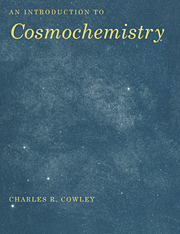Book contents
- Frontmatter
- Contents
- Foreword
- 1 Overview
- 2 Minerals: An Introduction to the Nomenclature and Chemistry
- 3 A Brief Introduction to Petrology
- 4 A Résumé of Thermodynamics and Statistical Mechanics
- 5 Condensation Sequences and the Geochemical Classification of the Elements
- 6 The Theory of the Bulk Composition of the Planets
- 7 Meteorites and the Standard Abundance Distribution (SAD)
- 8 An Introduction to Isotope Geology with an Emphasis on Meteorites
- 9 Some Concepts from Nuclear Physics
- 10 Energy Generation in Stars and Nucleosynthesis
- 11 Atomic and Molecular Spectra
- 12 The Analysis of Stellar Spectra
- 13 The Chemistry of Stars and Stellar Systems
- 14 Cold, Non-stellar Material in Galaxies
- 15 Emission-Line Regions and their Chemical Abundances
- 16 Abundances of the Elements in Galaxies
- Appendix
- References
- Index
11 - Atomic and Molecular Spectra
Published online by Cambridge University Press: 05 June 2012
- Frontmatter
- Contents
- Foreword
- 1 Overview
- 2 Minerals: An Introduction to the Nomenclature and Chemistry
- 3 A Brief Introduction to Petrology
- 4 A Résumé of Thermodynamics and Statistical Mechanics
- 5 Condensation Sequences and the Geochemical Classification of the Elements
- 6 The Theory of the Bulk Composition of the Planets
- 7 Meteorites and the Standard Abundance Distribution (SAD)
- 8 An Introduction to Isotope Geology with an Emphasis on Meteorites
- 9 Some Concepts from Nuclear Physics
- 10 Energy Generation in Stars and Nucleosynthesis
- 11 Atomic and Molecular Spectra
- 12 The Analysis of Stellar Spectra
- 13 The Chemistry of Stars and Stellar Systems
- 14 Cold, Non-stellar Material in Galaxies
- 15 Emission-Line Regions and their Chemical Abundances
- 16 Abundances of the Elements in Galaxies
- Appendix
- References
- Index
Summary
Introductory Remarks
The philosopher Auguste Comte (1798–1857) asserted that man would never know the chemical composition of the stars. It is therefore ironical that Gustav Kirchhoff (1824–1887) discovered the laws of spectroscopy at about the same time as Comte's death. With the help of the principles articulated by Kirchhoff we now claim knowledge of the composition not only of the nearby stars, but of galaxies so distant that it has taken a substantial fraction of the age of the universe for their light to reach us.
In this chapter we will review the laws of atomic and molecular spectroscopy that enable us to analyze the electromagnetic radiation from space. Naturally, we cannot give a complete account of these rather complicated topics. There is only space to highlight the nomenclature, and in some cases provide heuristic insight into the more important formulae.
The following chapters will deal with the application of atomic and molecular physics to chemical analyses of stars and stellar systems, and interstellar material.
Atomic Spectra: The Nomenclature of LS Coupling
The identification of spectral lines in a star is done with the help of certain reference volumes, the most important of which is possibly C. E. Moore's (1972) A Multiplet Table of Astrophysical Interest. While the basic work appeared as a series of the publications of the Princeton Observatory, the demand for this material was so great that it has gone through one major revision and innumerable reprints and updates.
- Type
- Chapter
- Information
- An Introduction to Cosmochemistry , pp. 230 - 259Publisher: Cambridge University PressPrint publication year: 1995

